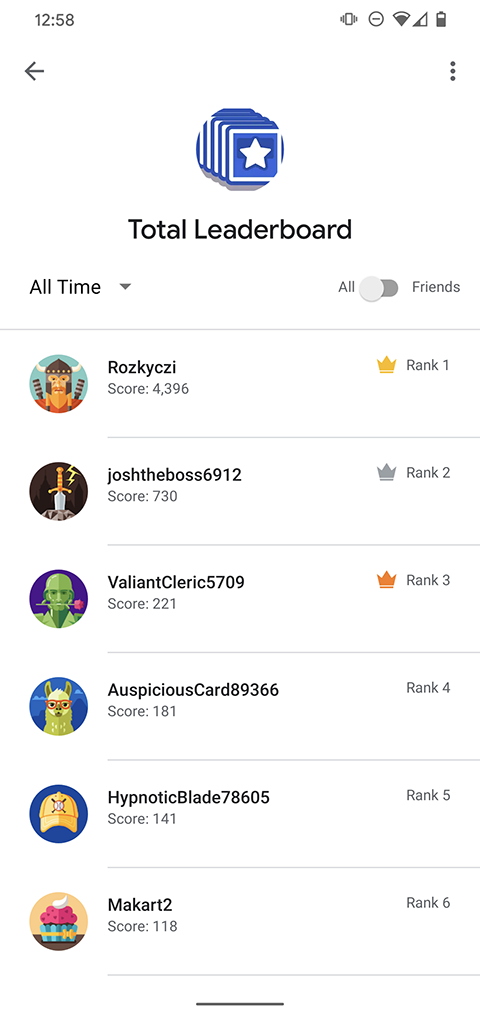Google Sign-In API가 지원 중단됨에 따라 2026년에 게임즈 v1 SDK가 삭제됩니다. 2025년 2월 이후에는 게임즈 v1 SDK와 새로 통합된 게임을 Google Play에 게시할 수 없습니다. 대신 게임즈 v2 SDK를 사용하는 것이 좋습니다.
이전 게임 v1 통합이 적용된 기존 게임은 몇 년간 계속 작동하지만 2025년 6월부터 v2로 이전하는 것이 좋습니다.
이 가이드는 Play 게임즈 서비스 v1 SDK 사용에 관한 내용입니다. 최신 SDK 버전에 관한 자세한 내용은 v2 문서를 참고하세요.
이 가이드에서는 Android 애플리케이션에서 리더보드 API를 사용하여 시각적 리더보드를 만들고 플레이어 점수를 기록하고 점수를 이전 게임 세션의 플레이어 점수와 비교하는 방법을 보여줍니다. API는 com.google.android.gms.games 및 com.google.android.gms.games.leaderboards 패키지에서 찾을 수 있습니다.
시작하기 전에
아직 검토하지 않았다면 리더보드 게임 개념을 검토하는 것이 좋습니다.
리더보드 API를 사용하여 코딩을 시작하기 전에 다음을 진행합니다.
- Google Play 서비스 SDK 설정 가이드에 따라, Google Play 게임즈 서비스를 사용하도록 앱을 설치하고 설정합니다.
- Google Play Console 가이드의 안내에 따라 게임에서 표시하거나 업데이트할 리더보드를 정의합니다.
- Android 샘플 페이지에서 리더보드 코드 샘플을 다운로드하여 검토합니다.
- 품질 체크리스트에 설명된 권장사항을 숙지합니다.
리더보드 클라이언트 가져오기
리더보드 API를 사용하려면 먼저 게임에서 LeaderboardsClient 객체를 가져와야 합니다.
이렇게 하려면 Games.getLeadeboardsClient() 메서드를 호출하고 활동과 현재 플레이어의 GoogleSignInAccount을 전달하면 됩니다. 플레이어 계정 정보를 검색하는 방법을 알아보려면 Android 게임 로그인을 참고하세요.
플레이어 점수 업데이트
플레이어의 점수가 변경(예: 플레이어가 게임을 완료했을 때)되면 LeaderboardsClient.submitScore()를 호출하고 리더보드 ID 및 원시 점수 값을 전달하여 리더보드의 점수를 업데이트할 수 있습니다.
다음 코드 스니펫은 앱에서 플레이어의 점수를 업데이트할 수 있는 방법을 보여줍니다.
Games.getLeaderboardsClient(this, GoogleSignIn.getLastSignedInAccount(this))
.submitScore(getString(R.string.leaderboard_id), 1337);게임에서 리소스 ID별로 리더보드를 참조할 수 있도록 strings.xml 파일에 리더보드 ID를 정의하는 것이 좋습니다. 플레이어 점수를 업데이트하고 로드하기 위해 호출을 실행한 경우 API 할당량을 초과하지 않도록 관련 권장사항도 따라야 합니다.
리더보드 표시
리더보드를 표시하려면 Intent를 가져올 LeaderboardsClient.getLeaderboardIntent()를 호출하여 기본 리더보드 사용자 인터페이스를 생성합니다. 그러면 게임이 startActivityForResult를 호출하여 UI를 불러올 수 있게 됩니다.
다음 코드 스니펫은 앱에서 플레이어의 점수를 업데이트할 수 있는 방법을 보여줍니다. 코드 스니펫에서 RC_LEADERBOARD_UI는 요청 코드의 임의 정수입니다.
private static final int RC_LEADERBOARD_UI = 9004; private void showLeaderboard() { Games.getLeaderboardsClient(this, GoogleSignIn.getLastSignedInAccount(this)) .getLeaderboardIntent(getString(R.string.leaderboard_id)) .addOnSuccessListener(new OnSuccessListener<Intent>() { @Override public void onSuccess(Intent intent) { startActivityForResult(intent, RC_LEADERBOARD_UI); } }); }
반환되는 결과가 없더라도 API가 호출 패키지의 ID를 가져올 수 있도록 startActivityForResult를 사용해야 합니다. 기본 리더보드 UI의 예가 아래에 나와 있습니다.


